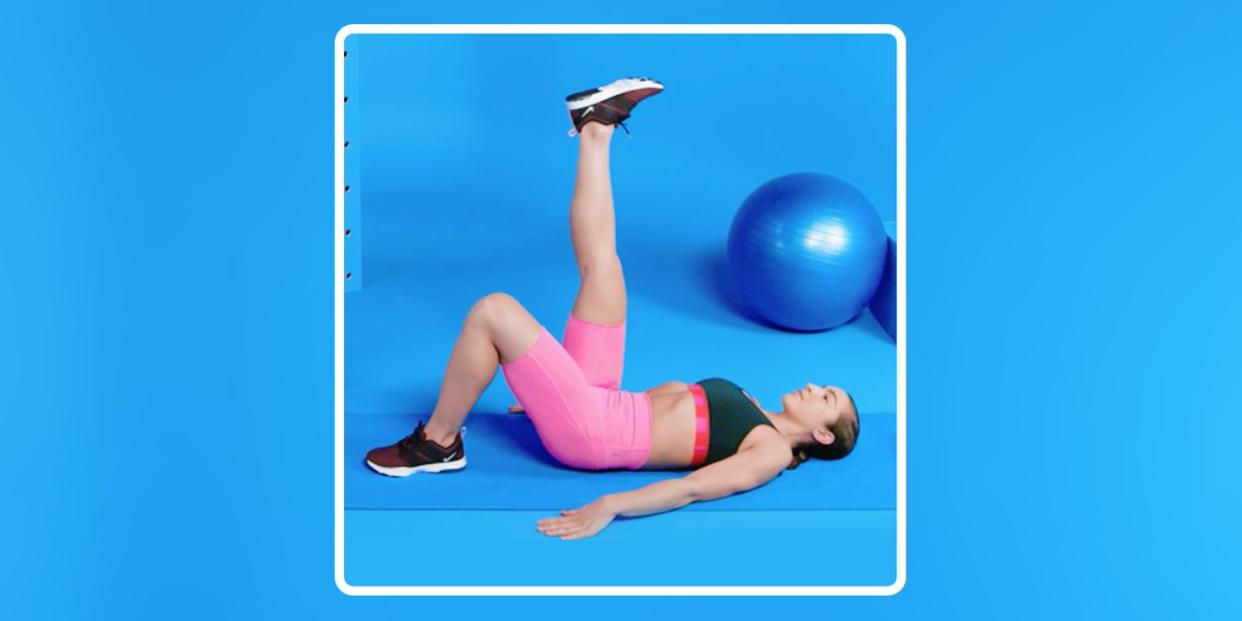You should really do this exercise if you sit at a desk all day

Every runner will struggle with lazy glutes, especially if you find yourself sitting down for most of the day. The solution? Add single-leg glute bridges to your routine.
Driving through just one leg helps isolate the glute muscles, but it also incorporates your other posterior muscles and makes this beloved move way more intense, says NASM-certified trainer Whitney Johns, instructor with personal training app Plankk Studio.
How to do a single-leg bridge
How to: Lie on your back with knees bent, feet shoulder-width apart and 12–16 inches from glutes. Lift your right leg so it's straight up in the air at hip height with your foot flexed. Keeping your upper back on the floor, engage your glutes, drive through your left heel, and raise your hips off the ground until your knee, hips, and shoulders form a straight line. Keep your core engaged the entire time. Pause at the top, squeezing your glutes for one to two seconds. Then lower back down to the start. Complete all your reps, then switch legs.
Reps/sets for best results: Without weight, aim for three sets of 15 to 20 reps. If adding weight, lower that to 12 reps. Rest for 30 seconds between each set.
Form tips: Be sure to fully extend your hips at the top of the movement, and that you’re driving from the heels and hips, not from the legs, Johns says. Also, it's important to note that the clench and pause at the top of this movement are crucial for full muscle fibre engagement, Johns says.
Benefits Of Single-Leg Bridge
Just like with your standard glute bridge, the single-leg variety targets all three glute muscles—that’s the maximus, medius, and minimus. But lifting one leg adds work to your hamstrings and your lower back, making it much more intense than the bilateral (i.e. two-legged) variety, Johns says.
The bridge builds functionality and aesthetics, she adds. “This move is great for any desk-bound worker because it improves hip mobility and lower-back strength," Jons explains. "Sitting at a desk really weakens glutes and can lead to lower-back problems.”
Single-leg glute bridges are challenging without any weight, but once you build a foundation of strength and movement, you can slowly add weight—a dumbbell or barbell across your hip bones is usually easiest, according to Johns.
Make single-leg bridges part of your workout
Start doing single-leg glute bridges two to three times a week with no weights. As you build your strength and mastery of the movement, you can start adding weight—but drop down to just once per week to help build out those glutes, while giving them time to recover, Johns advises.
For supersets, pair this exercise with a counter movements, like a superman, or do all three sets on their own along with other leg exercises.
There are countless variations to this exercise, too:
Elevated Single-Leg Glute Bridge: Complete same movement as described above, but with one foot on the floor and one foot elevated on a Bosu ball or bench.
Single-Leg Glute Bridge With Weight: Perform the same movement as single-leg glute bridge, but with a barbell, dumbbell, or kettlebell placed over the center of your hips.
Banded Single-Leg Glute Bridge: Execute the exercise as is, but with a resistance band wrapped around your thighs.
Single-Leg Glute Bridge On Bench: Place your upper back on flat bench, with one foot flat on the ground and the other extended straight ahead at hip height. Lower your hips, then press up driving through your heels to raise hips to bench height, squeezing your glutes. Then lower back down, repeat.
('You Might Also Like',)


